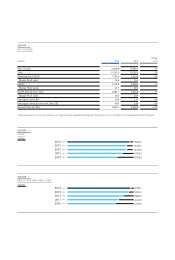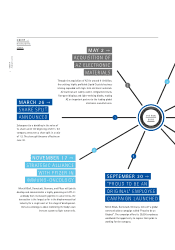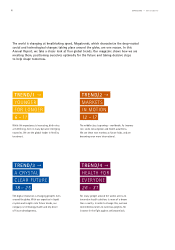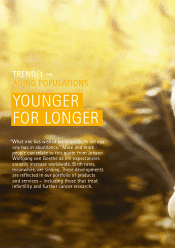Merck 2014 Annual Report Download - page 13
Download and view the complete annual report
Please find page 13 of the 2014 Merck annual report below. You can navigate through the pages in the report by either clicking on the pages listed below, or by using the keyword search tool below to find specific information within the annual report.
8MAGAZINE → Younger for Longer
Latin America
and the Caribbean
7.6 % Europe
5.4 %
Africa
32.2 %
Asia
50.7 %
Northern
America
3.6 %
Oceania
0.5 %
1970
Fertility rate
2030
1.0
2.2
3.4
4.6
5.8
7.0
→
Birth
distribution
worldwide
2030
“Catch me if you can!” yells Lovis as he
races across the playground. Little Henri
runs behind his older brother, shouting.
The two boys keep their parents on their
toes. But for Silke (41) and Jens (44),
achieving this happy family was a long
and difficult process. “At around the age
of 30, I felt ready to start a family. At
the time, Jens was still in awe of the
responsibility of having a family, but I was
able to convince him. Then, however,
I couldn’t get pregnant,” Silke explains.
There was a medical reason for this. When
she was 17 Silke suffered from pelvic
inflammatory disease, which blocked her
fallopian tubes. “Although I had suspected
this, it still came as a shock,” Silke recalls.
After numerous discussions, the couple
decided to try artificial insemination. One
frequently used method is in vitro fertil-
ization (IVF), a procedure in which the egg
is fertilized outside the body. After ovula-
tion is induced, the egg cells are removed
through the vagina and placed in a test
tube with the sperm and then transferred
back afterwards. “The treatment took three
years; it was not an easy time for us,” says
Jens. Silke agrees, “I put myself under
tremendous pressure and suffered from
mood swings. And the negative test results
made me very sad.” Not until the seventh
attempt did they suddenly hear the words,
“Congratulations, you’re pregnant!” The
elation over the birth of Lovis in February
2008 was followed by another shock. The
baby had cerebral hemorrhaging. “After a
difficult period, Lovis is a happy, normal
boy today,” the parents report with relief.
And he now has a younger brother to play
with. Henri was born in summer 2011. This
time, Silke became pregnant immediately
after the first attempt. “Maybe it was
because I was much more relaxed,” Silke
says today. Silke and Jens experienced an
“emotional rollercoaster” during their
efforts to become parents. Artificial in-
semination was ultimately successful,
however – twice in fact. “We wanted these
children so very much,” the couple says
with conviction, gazing with pride at their
sons.
FULFILLING THE DESIRE FOR
CHILDREN THROUGH FERTILITY
TREATMENT
What Silke and Jens went through is cer-
tainly no isolated case.
Roughly one in seven couples in Germany
is unable to bear children due to fertility
disorders. The yearning to have a baby of
their own can quickly become a tale of
woe. But many couples are able to fulfill
their desire for a child through artificial
insemination. The per-cycle success rate
for in vitro fertilization is about 70 %.
Hormone therapy is of decisive importance
in treating infertility. As the world leader
in the fertility drug industry, Merck KGaA,
Darmstadt, Germany, supplies hormones
for each phase of the reproductive cycle –
from developing the egg cell to the early
stage of pregnancy. The company has also
developed a wealth of products in this
area, including a computerized test that
improves the prospects of a successful
pregnancy by identifying viable embryos.
As a result of the intensive research and
development efforts, around two million
children have now been born thanks to its
products.
“There are many causes of fertility disor-
ders. Half of cases are due to women, the
other half to men. However, in many cases
advanced age is the reason,” says Professor
Dr. Heribert Kentenich from the Fertility
Center Berlin. Particularly in modern in-
dustrial nations, career plans or individual
fulfillment come first and many couples
delay family planning – sometimes for
too long. “By the age of 30, a woman’s
probability of a successful pregnancy be-
gins to decline, and at 40 the odds become
very low,” Professor Kentenich explains.
Despite this, the trend is clear: Fewer and
fewer women are having their first child
before the age of 30. Naturally, the topic of
FERTILITY →
BIRTH RATES AND DISTRIBUTION
Worldwide by region
On average, women are bearing fewer and fewer children.
In Asia, the fertility rate is likely to decline significantly.
Yet according to a forecast of the global distribution of births in 2030,
in absolute terms the majority of children will be born in Asia.
Source: United Nations, World Fertility Patterns 2013
























